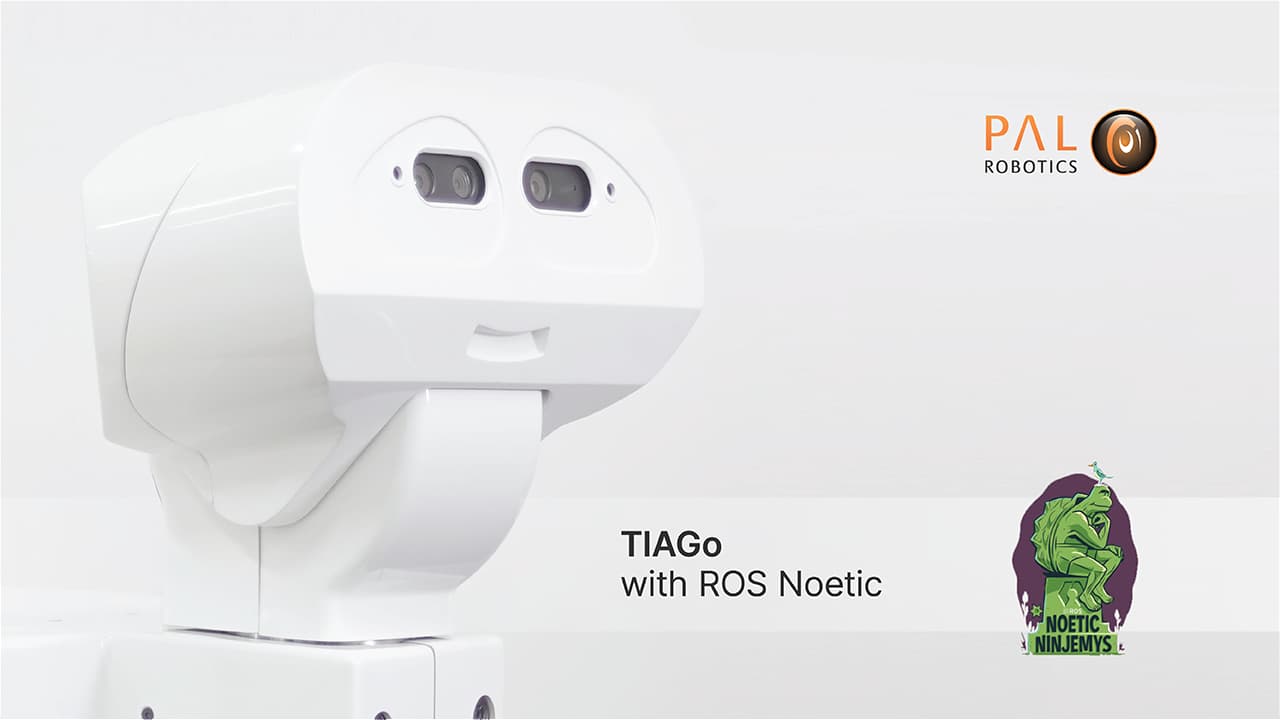Discover TIAGo Gallium
We are happy to announce that TIAGo the mobile manipulator is now available with ROS Noetic – the thirteenth ROS distribution release of Robot Operating System (ROS), the most popular framework for programming robots.
Compared to the previous release ROS Melodic, ROS Noetic mainly features Python 3, allowing users to port their ROS packages to Python 3. The version of Python in ROS Noetic is Python 3 (3.8). ROS Noetic is also using Gazebo 11, versus Gazebo 9 in ROS Melodic. ROS Noetic is the final official release of ROS 1.
The main change between ROS Melodic and ROS Noetic is that ROS Noetic targets Ubuntu 20.04/Focal Fossa and uses Python 3, meaning developers in ROS Noetic can take advantage of Python 3 library’s numerous benefits. Some of these benefits include:
- More predictable divisions
- Advanced iterable unpacking
- Print is a built-in function
- Unicode support.
We look forward to seeing ROS Noetic being used for upcoming developments by our TIAGo robot customers worldwide!
TIAGo resources: getting started
There are tutorials on how to use TIAGo robot available in the Wiki ROS, which work both in Melodic and in the new ROS distro Noetic. These tutorials including navigation (with one or more TIAGo robots), perception, and manipulation. All material used is available in the Github packages on TIAGo robot, which contain the description, controller configuration of the robot, along with other tools that may be useful for your research.
See also the docker containers with our public simulation with the various TIAGo robot options: TIAGo Base (Differential drive and Omnidirectional), TIAGo, and TIAGo dual.
Your TIAGo: upgrade your robot to ROS Noetic
If you are already the owner of a TIAGo robot, the new PAL Robotics distro Gallium (Ubuntu 20.04 + ROS Noetic package) is now ready to override the previous distro, Ferrum (Ubuntu 18.04 + ROS Melodic).
To find out more and start the process with your TIAGo, get in touch with us.
ROS Noetic and Python 3: for Reinforcement Learning
One of the major changes in the migration of ROS distribution from Melodic to Noetic is the usage of Python 3. This is of particular interest in robotics in many fields of application, as there is a vast state-of-the-art software on Machine Learning and Reinforcement Learning written in Python 3 that is currently being maintained.
The migration to Gallium (Ubuntu 20.04 + ROS Noetic package) allows, from this moment on, to deploy and use code written in Python 3 directly in your TIAGo robot, hence opening the door to gathering data from sensors and processing it, fitting models, and even applying Reinforcement Learning techniques in robotics applications interfacing through ROS topics. These models are typically learned in simulation and later applied in the hardware and with this new distro, this procedure can be done straight away!
Python 3 offers a number of libraries suitable for reinforcement learning. Some examples include:
- Pyqlearning – a package that aims to design a reinforcement learning algorithm rather than a single API for learning, meaning users can experiment more.
- ChainerRL – this GitHub package offers learning materials and implements various state-of-the-art deep reinforcement algorithms in Python.
- Gymnasium – a Python package offering a standard API for Reinforcement Learning developed by OpenAI.
- KerasRL – implements state-of-the-art deep reinforcement learning algorithms with Keras deep learning library.
- Tensorforce – an open-source deep reinforcement learning framework built on top of Google’s TensorFlow framework.
TIAGo: the modular research platform, social robot and mobile manipulator
TIAGo robot combines perception, navigation, manipulation & Human-Robot Interaction skills out of the box. TIAGo is a standard research platform and one of the most used robots for research in universities and innovation centers all over the world.
TIAGo robot has a modular design and can be configured based on your needs, and customized with its countless expansion possibilities. The arm has a large manipulation workspace, being able to reach the ground as well as high shelves. The end effector can be a gripper or a humanoid hand and they can be quickly and easily exchanged to make the platform suited to different types of research and use cases.
The robot is popular in robotics competitions and has taken part in RoboCup and IROS the Mobile Manipulation Hackathon, amongst others. Some of the research fields TIAGo is used in by universities and EU research projects include Industry 4.0, IoT, benchmarking and Ambient Assisted Living.
TIAGo: configurations, end-effectors and grippers
TIAGo is configurable based on your research needs, and can also be customized with different end-effectors including grippers.
- Check out possible TIAGo configurations by trying out our TIAGo configurator for yourself with the different options available on our website.
- Our TIAGo robot is available with a range of different end-effectors which can be interchanged by the user. Find out more about TIAGo end-effectors in our previous blog post.
- These end effectors include the Robotiq grippers 2F-85, 2F-140, and EPick grippers, take a look at these in our video.
Read more about ROS Noetic and how to install the programme and don’t miss our other news in our blog.
To find out how to upgrade your TIAGo robot to ROS Noetic, get in touch with our team. Learn more about TIAGo the mobile manipulator and the endless possibilities for your research that the robot supports.
